HR's Impact on Organisational Success: A Case Study of Unilever Plc
VerifiedAdded on 2023/06/07
|9
|2662
|454
Report
AI Summary
This report evaluates the importance of organisational design theory in relation to organisational structure and strategy, using Unilever Plc as a case study. It analyses different approaches and techniques used by Unilever for attracting, maintaining, developing, and rewarding human resources to create a skilled and dedicated workforce. The report also explores emerging HR developments, such as hybrid work models and a focus on employee well-being, supported by contemporary knowledge. It highlights Unilever's adoption of a tall organisational structure and various HR practices aimed at enhancing employee satisfaction, skills development, and overall organisational efficiency. The analysis emphasizes the role of technology and employee-centric approaches in modern HR practices.
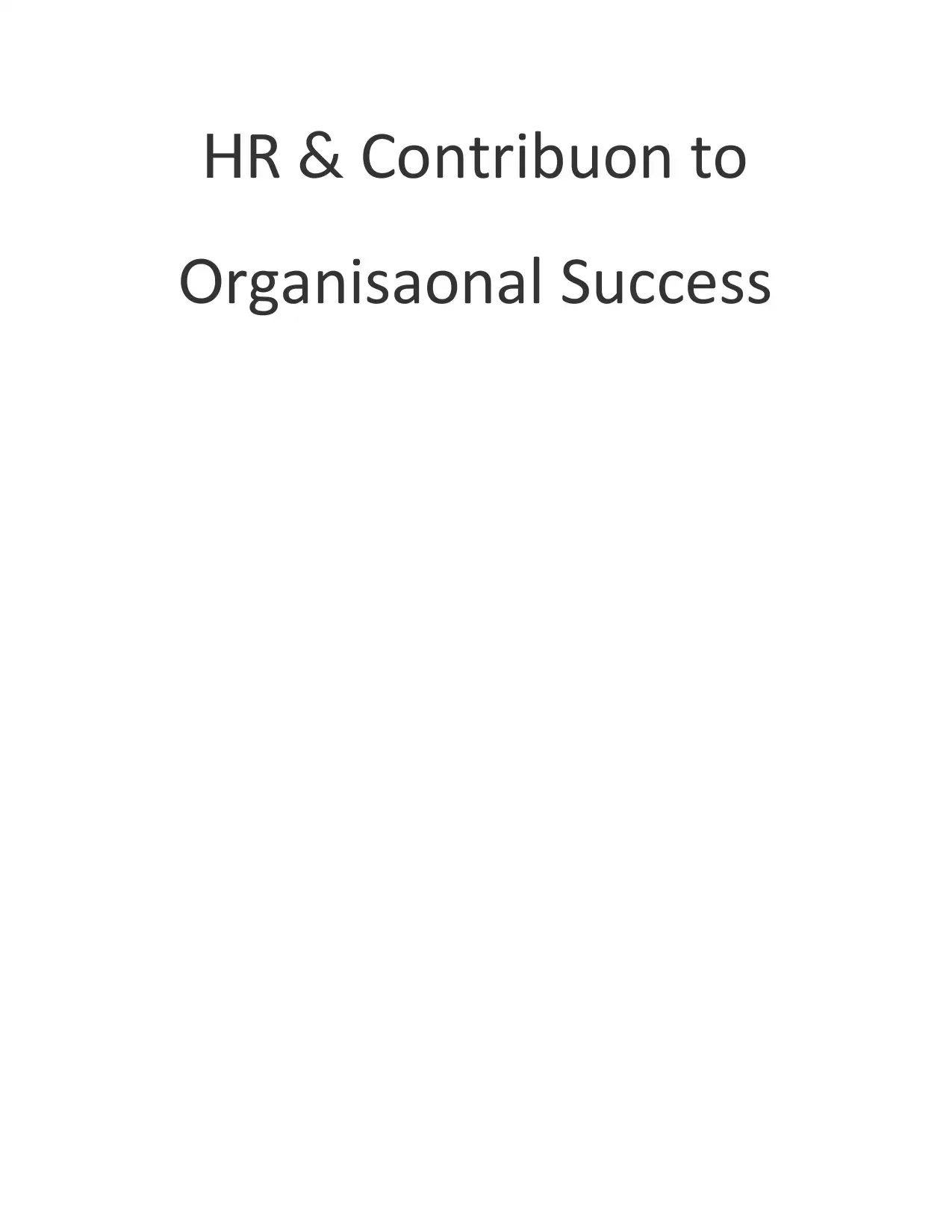
R Contribution toH &
rganisational SuccessO
rganisational SuccessO
Paraphrase This Document
Need a fresh take? Get an instant paraphrase of this document with our AI Paraphraser
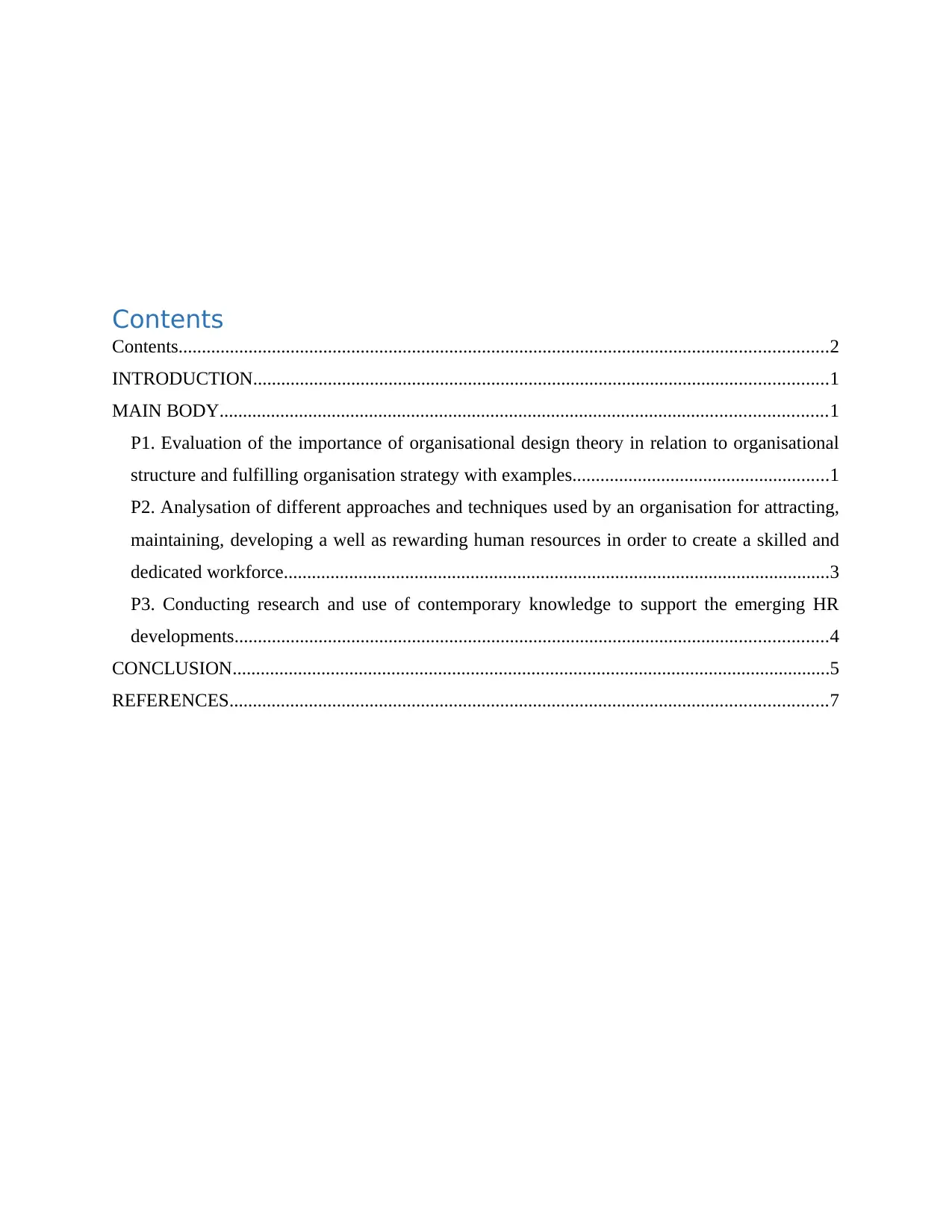
Contents
Contents...........................................................................................................................................2
INTRODUCTION...........................................................................................................................1
MAIN BODY..................................................................................................................................1
P1. Evaluation of the importance of organisational design theory in relation to organisational
structure and fulfilling organisation strategy with examples.......................................................1
P2. Analysation of different approaches and techniques used by an organisation for attracting,
maintaining, developing a well as rewarding human resources in order to create a skilled and
dedicated workforce.....................................................................................................................3
P3. Conducting research and use of contemporary knowledge to support the emerging HR
developments...............................................................................................................................4
CONCLUSION................................................................................................................................5
REFERENCES................................................................................................................................7
Contents...........................................................................................................................................2
INTRODUCTION...........................................................................................................................1
MAIN BODY..................................................................................................................................1
P1. Evaluation of the importance of organisational design theory in relation to organisational
structure and fulfilling organisation strategy with examples.......................................................1
P2. Analysation of different approaches and techniques used by an organisation for attracting,
maintaining, developing a well as rewarding human resources in order to create a skilled and
dedicated workforce.....................................................................................................................3
P3. Conducting research and use of contemporary knowledge to support the emerging HR
developments...............................................................................................................................4
CONCLUSION................................................................................................................................5
REFERENCES................................................................................................................................7
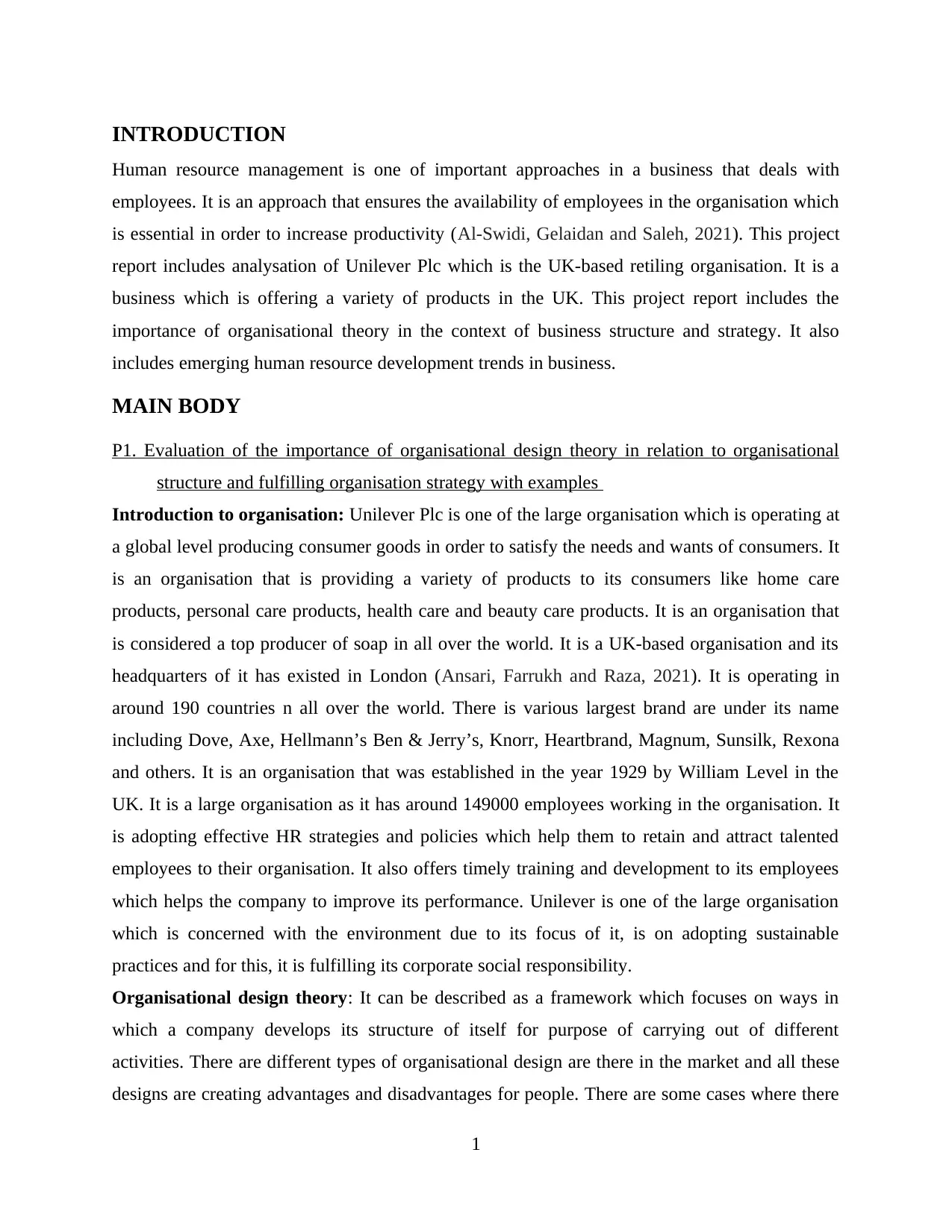
INTRODUCTION
Human resource management is one of important approaches in a business that deals with
employees. It is an approach that ensures the availability of employees in the organisation which
is essential in order to increase productivity (Al-Swidi, Gelaidan and Saleh, 2021). This project
report includes analysation of Unilever Plc which is the UK-based retiling organisation. It is a
business which is offering a variety of products in the UK. This project report includes the
importance of organisational theory in the context of business structure and strategy. It also
includes emerging human resource development trends in business.
MAIN BODY
P1. Evaluation of the importance of organisational design theory in relation to organisational
structure and fulfilling organisation strategy with examples
Introduction to organisation: Unilever Plc is one of the large organisation which is operating at
a global level producing consumer goods in order to satisfy the needs and wants of consumers. It
is an organisation that is providing a variety of products to its consumers like home care
products, personal care products, health care and beauty care products. It is an organisation that
is considered a top producer of soap in all over the world. It is a UK-based organisation and its
headquarters of it has existed in London (Ansari, Farrukh and Raza, 2021). It is operating in
around 190 countries n all over the world. There is various largest brand are under its name
including Dove, Axe, Hellmann’s Ben & Jerry’s, Knorr, Heartbrand, Magnum, Sunsilk, Rexona
and others. It is an organisation that was established in the year 1929 by William Level in the
UK. It is a large organisation as it has around 149000 employees working in the organisation. It
is adopting effective HR strategies and policies which help them to retain and attract talented
employees to their organisation. It also offers timely training and development to its employees
which helps the company to improve its performance. Unilever is one of the large organisation
which is concerned with the environment due to its focus of it, is on adopting sustainable
practices and for this, it is fulfilling its corporate social responsibility.
Organisational design theory: It can be described as a framework which focuses on ways in
which a company develops its structure of itself for purpose of carrying out of different
activities. There are different types of organisational design are there in the market and all these
designs are creating advantages and disadvantages for people. There are some cases where there
1
Human resource management is one of important approaches in a business that deals with
employees. It is an approach that ensures the availability of employees in the organisation which
is essential in order to increase productivity (Al-Swidi, Gelaidan and Saleh, 2021). This project
report includes analysation of Unilever Plc which is the UK-based retiling organisation. It is a
business which is offering a variety of products in the UK. This project report includes the
importance of organisational theory in the context of business structure and strategy. It also
includes emerging human resource development trends in business.
MAIN BODY
P1. Evaluation of the importance of organisational design theory in relation to organisational
structure and fulfilling organisation strategy with examples
Introduction to organisation: Unilever Plc is one of the large organisation which is operating at
a global level producing consumer goods in order to satisfy the needs and wants of consumers. It
is an organisation that is providing a variety of products to its consumers like home care
products, personal care products, health care and beauty care products. It is an organisation that
is considered a top producer of soap in all over the world. It is a UK-based organisation and its
headquarters of it has existed in London (Ansari, Farrukh and Raza, 2021). It is operating in
around 190 countries n all over the world. There is various largest brand are under its name
including Dove, Axe, Hellmann’s Ben & Jerry’s, Knorr, Heartbrand, Magnum, Sunsilk, Rexona
and others. It is an organisation that was established in the year 1929 by William Level in the
UK. It is a large organisation as it has around 149000 employees working in the organisation. It
is adopting effective HR strategies and policies which help them to retain and attract talented
employees to their organisation. It also offers timely training and development to its employees
which helps the company to improve its performance. Unilever is one of the large organisation
which is concerned with the environment due to its focus of it, is on adopting sustainable
practices and for this, it is fulfilling its corporate social responsibility.
Organisational design theory: It can be described as a framework which focuses on ways in
which a company develops its structure of itself for purpose of carrying out of different
activities. There are different types of organisational design are there in the market and all these
designs are creating advantages and disadvantages for people. There are some cases where there
1
⊘ This is a preview!⊘
Do you want full access?
Subscribe today to unlock all pages.

Trusted by 1+ million students worldwide
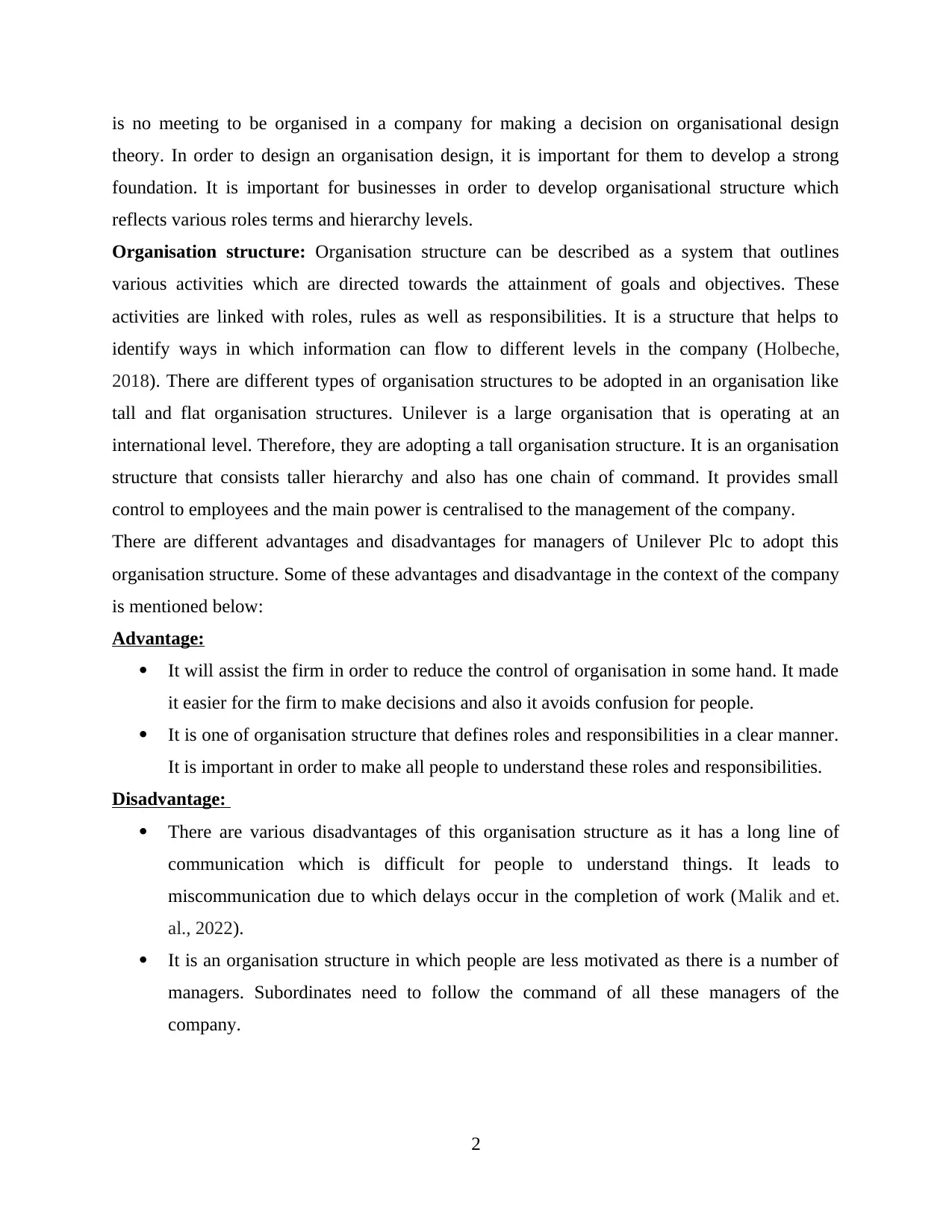
is no meeting to be organised in a company for making a decision on organisational design
theory. In order to design an organisation design, it is important for them to develop a strong
foundation. It is important for businesses in order to develop organisational structure which
reflects various roles terms and hierarchy levels.
Organisation structure: Organisation structure can be described as a system that outlines
various activities which are directed towards the attainment of goals and objectives. These
activities are linked with roles, rules as well as responsibilities. It is a structure that helps to
identify ways in which information can flow to different levels in the company (Holbeche,
2018). There are different types of organisation structures to be adopted in an organisation like
tall and flat organisation structures. Unilever is a large organisation that is operating at an
international level. Therefore, they are adopting a tall organisation structure. It is an organisation
structure that consists taller hierarchy and also has one chain of command. It provides small
control to employees and the main power is centralised to the management of the company.
There are different advantages and disadvantages for managers of Unilever Plc to adopt this
organisation structure. Some of these advantages and disadvantage in the context of the company
is mentioned below:
Advantage:
It will assist the firm in order to reduce the control of organisation in some hand. It made
it easier for the firm to make decisions and also it avoids confusion for people.
It is one of organisation structure that defines roles and responsibilities in a clear manner.
It is important in order to make all people to understand these roles and responsibilities.
Disadvantage:
There are various disadvantages of this organisation structure as it has a long line of
communication which is difficult for people to understand things. It leads to
miscommunication due to which delays occur in the completion of work (Malik and et.
al., 2022).
It is an organisation structure in which people are less motivated as there is a number of
managers. Subordinates need to follow the command of all these managers of the
company.
2
theory. In order to design an organisation design, it is important for them to develop a strong
foundation. It is important for businesses in order to develop organisational structure which
reflects various roles terms and hierarchy levels.
Organisation structure: Organisation structure can be described as a system that outlines
various activities which are directed towards the attainment of goals and objectives. These
activities are linked with roles, rules as well as responsibilities. It is a structure that helps to
identify ways in which information can flow to different levels in the company (Holbeche,
2018). There are different types of organisation structures to be adopted in an organisation like
tall and flat organisation structures. Unilever is a large organisation that is operating at an
international level. Therefore, they are adopting a tall organisation structure. It is an organisation
structure that consists taller hierarchy and also has one chain of command. It provides small
control to employees and the main power is centralised to the management of the company.
There are different advantages and disadvantages for managers of Unilever Plc to adopt this
organisation structure. Some of these advantages and disadvantage in the context of the company
is mentioned below:
Advantage:
It will assist the firm in order to reduce the control of organisation in some hand. It made
it easier for the firm to make decisions and also it avoids confusion for people.
It is one of organisation structure that defines roles and responsibilities in a clear manner.
It is important in order to make all people to understand these roles and responsibilities.
Disadvantage:
There are various disadvantages of this organisation structure as it has a long line of
communication which is difficult for people to understand things. It leads to
miscommunication due to which delays occur in the completion of work (Malik and et.
al., 2022).
It is an organisation structure in which people are less motivated as there is a number of
managers. Subordinates need to follow the command of all these managers of the
company.
2
Paraphrase This Document
Need a fresh take? Get an instant paraphrase of this document with our AI Paraphraser
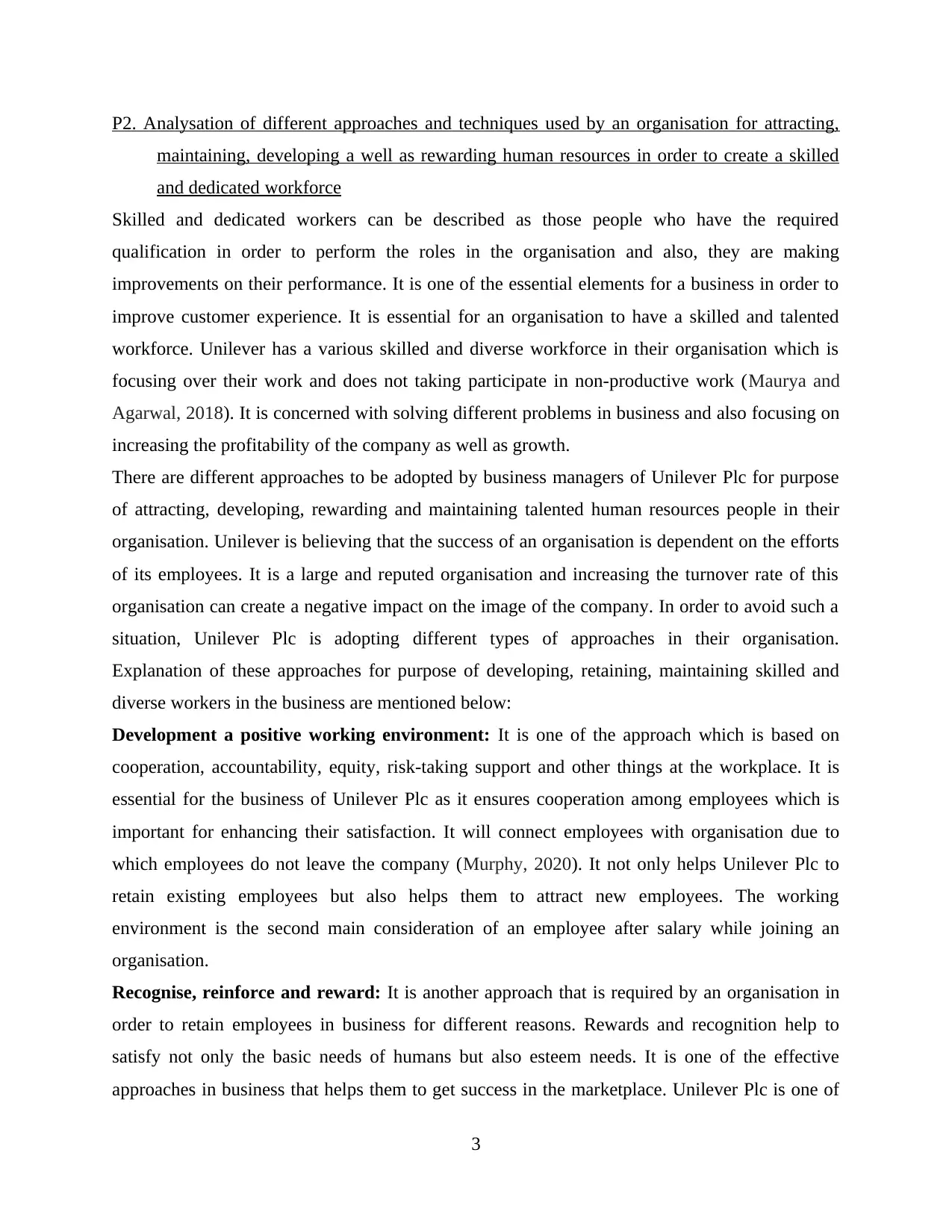
P2. Analysation of different approaches and techniques used by an organisation for attracting,
maintaining, developing a well as rewarding human resources in order to create a skilled
and dedicated workforce
Skilled and dedicated workers can be described as those people who have the required
qualification in order to perform the roles in the organisation and also, they are making
improvements on their performance. It is one of the essential elements for a business in order to
improve customer experience. It is essential for an organisation to have a skilled and talented
workforce. Unilever has a various skilled and diverse workforce in their organisation which is
focusing over their work and does not taking participate in non-productive work (Maurya and
Agarwal, 2018). It is concerned with solving different problems in business and also focusing on
increasing the profitability of the company as well as growth.
There are different approaches to be adopted by business managers of Unilever Plc for purpose
of attracting, developing, rewarding and maintaining talented human resources people in their
organisation. Unilever is believing that the success of an organisation is dependent on the efforts
of its employees. It is a large and reputed organisation and increasing the turnover rate of this
organisation can create a negative impact on the image of the company. In order to avoid such a
situation, Unilever Plc is adopting different types of approaches in their organisation.
Explanation of these approaches for purpose of developing, retaining, maintaining skilled and
diverse workers in the business are mentioned below:
Development a positive working environment: It is one of the approach which is based on
cooperation, accountability, equity, risk-taking support and other things at the workplace. It is
essential for the business of Unilever Plc as it ensures cooperation among employees which is
important for enhancing their satisfaction. It will connect employees with organisation due to
which employees do not leave the company (Murphy, 2020). It not only helps Unilever Plc to
retain existing employees but also helps them to attract new employees. The working
environment is the second main consideration of an employee after salary while joining an
organisation.
Recognise, reinforce and reward: It is another approach that is required by an organisation in
order to retain employees in business for different reasons. Rewards and recognition help to
satisfy not only the basic needs of humans but also esteem needs. It is one of the effective
approaches in business that helps them to get success in the marketplace. Unilever Plc is one of
3
maintaining, developing a well as rewarding human resources in order to create a skilled
and dedicated workforce
Skilled and dedicated workers can be described as those people who have the required
qualification in order to perform the roles in the organisation and also, they are making
improvements on their performance. It is one of the essential elements for a business in order to
improve customer experience. It is essential for an organisation to have a skilled and talented
workforce. Unilever has a various skilled and diverse workforce in their organisation which is
focusing over their work and does not taking participate in non-productive work (Maurya and
Agarwal, 2018). It is concerned with solving different problems in business and also focusing on
increasing the profitability of the company as well as growth.
There are different approaches to be adopted by business managers of Unilever Plc for purpose
of attracting, developing, rewarding and maintaining talented human resources people in their
organisation. Unilever is believing that the success of an organisation is dependent on the efforts
of its employees. It is a large and reputed organisation and increasing the turnover rate of this
organisation can create a negative impact on the image of the company. In order to avoid such a
situation, Unilever Plc is adopting different types of approaches in their organisation.
Explanation of these approaches for purpose of developing, retaining, maintaining skilled and
diverse workers in the business are mentioned below:
Development a positive working environment: It is one of the approach which is based on
cooperation, accountability, equity, risk-taking support and other things at the workplace. It is
essential for the business of Unilever Plc as it ensures cooperation among employees which is
important for enhancing their satisfaction. It will connect employees with organisation due to
which employees do not leave the company (Murphy, 2020). It not only helps Unilever Plc to
retain existing employees but also helps them to attract new employees. The working
environment is the second main consideration of an employee after salary while joining an
organisation.
Recognise, reinforce and reward: It is another approach that is required by an organisation in
order to retain employees in business for different reasons. Rewards and recognition help to
satisfy not only the basic needs of humans but also esteem needs. It is one of the effective
approaches in business that helps them to get success in the marketplace. Unilever Plc is one of
3
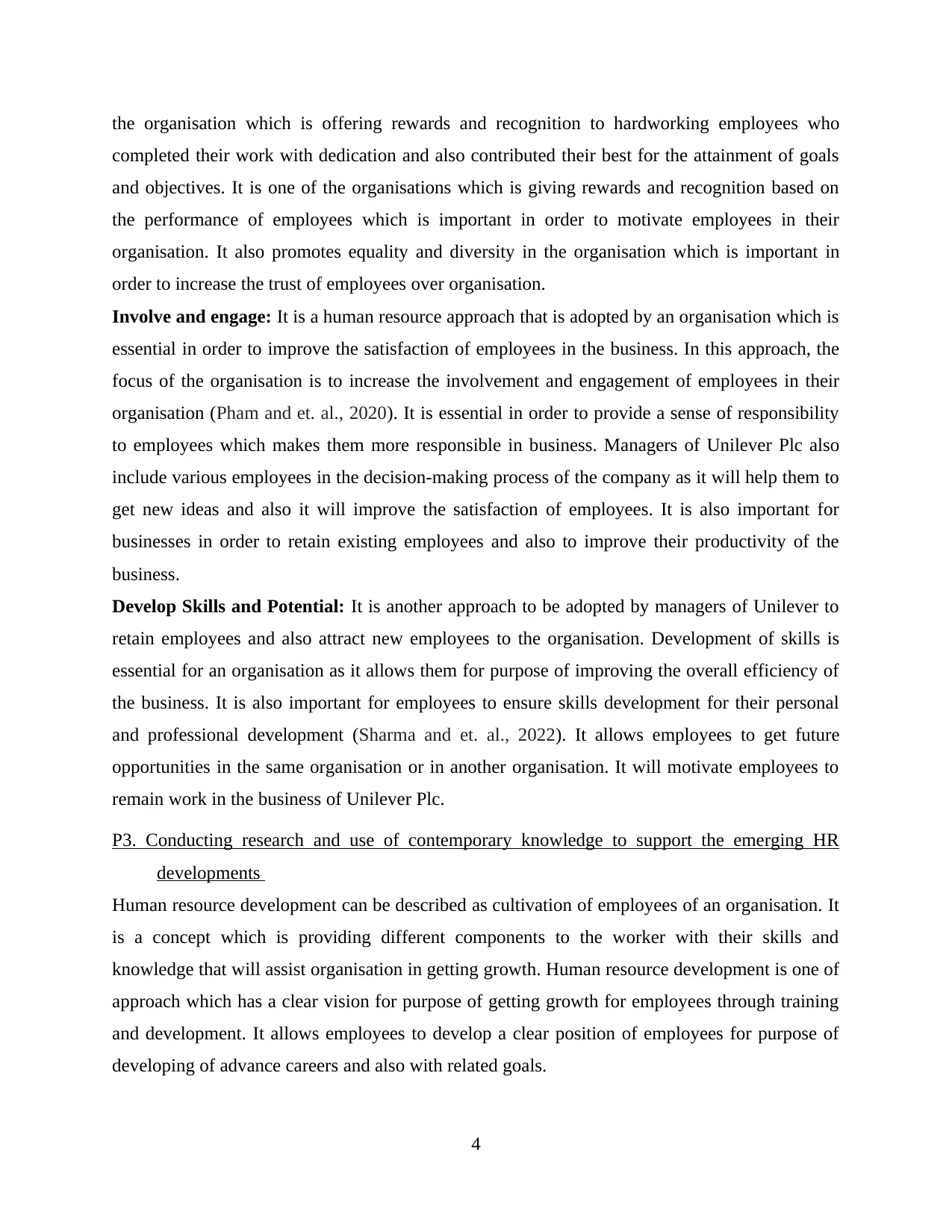
the organisation which is offering rewards and recognition to hardworking employees who
completed their work with dedication and also contributed their best for the attainment of goals
and objectives. It is one of the organisations which is giving rewards and recognition based on
the performance of employees which is important in order to motivate employees in their
organisation. It also promotes equality and diversity in the organisation which is important in
order to increase the trust of employees over organisation.
Involve and engage: It is a human resource approach that is adopted by an organisation which is
essential in order to improve the satisfaction of employees in the business. In this approach, the
focus of the organisation is to increase the involvement and engagement of employees in their
organisation (Pham and et. al., 2020). It is essential in order to provide a sense of responsibility
to employees which makes them more responsible in business. Managers of Unilever Plc also
include various employees in the decision-making process of the company as it will help them to
get new ideas and also it will improve the satisfaction of employees. It is also important for
businesses in order to retain existing employees and also to improve their productivity of the
business.
Develop Skills and Potential: It is another approach to be adopted by managers of Unilever to
retain employees and also attract new employees to the organisation. Development of skills is
essential for an organisation as it allows them for purpose of improving the overall efficiency of
the business. It is also important for employees to ensure skills development for their personal
and professional development (Sharma and et. al., 2022). It allows employees to get future
opportunities in the same organisation or in another organisation. It will motivate employees to
remain work in the business of Unilever Plc.
P3. Conducting research and use of contemporary knowledge to support the emerging HR
developments
Human resource development can be described as cultivation of employees of an organisation. It
is a concept which is providing different components to the worker with their skills and
knowledge that will assist organisation in getting growth. Human resource development is one of
approach which has a clear vision for purpose of getting growth for employees through training
and development. It allows employees to develop a clear position of employees for purpose of
developing of advance careers and also with related goals.
4
completed their work with dedication and also contributed their best for the attainment of goals
and objectives. It is one of the organisations which is giving rewards and recognition based on
the performance of employees which is important in order to motivate employees in their
organisation. It also promotes equality and diversity in the organisation which is important in
order to increase the trust of employees over organisation.
Involve and engage: It is a human resource approach that is adopted by an organisation which is
essential in order to improve the satisfaction of employees in the business. In this approach, the
focus of the organisation is to increase the involvement and engagement of employees in their
organisation (Pham and et. al., 2020). It is essential in order to provide a sense of responsibility
to employees which makes them more responsible in business. Managers of Unilever Plc also
include various employees in the decision-making process of the company as it will help them to
get new ideas and also it will improve the satisfaction of employees. It is also important for
businesses in order to retain existing employees and also to improve their productivity of the
business.
Develop Skills and Potential: It is another approach to be adopted by managers of Unilever to
retain employees and also attract new employees to the organisation. Development of skills is
essential for an organisation as it allows them for purpose of improving the overall efficiency of
the business. It is also important for employees to ensure skills development for their personal
and professional development (Sharma and et. al., 2022). It allows employees to get future
opportunities in the same organisation or in another organisation. It will motivate employees to
remain work in the business of Unilever Plc.
P3. Conducting research and use of contemporary knowledge to support the emerging HR
developments
Human resource development can be described as cultivation of employees of an organisation. It
is a concept which is providing different components to the worker with their skills and
knowledge that will assist organisation in getting growth. Human resource development is one of
approach which has a clear vision for purpose of getting growth for employees through training
and development. It allows employees to develop a clear position of employees for purpose of
developing of advance careers and also with related goals.
4
⊘ This is a preview!⊘
Do you want full access?
Subscribe today to unlock all pages.

Trusted by 1+ million students worldwide
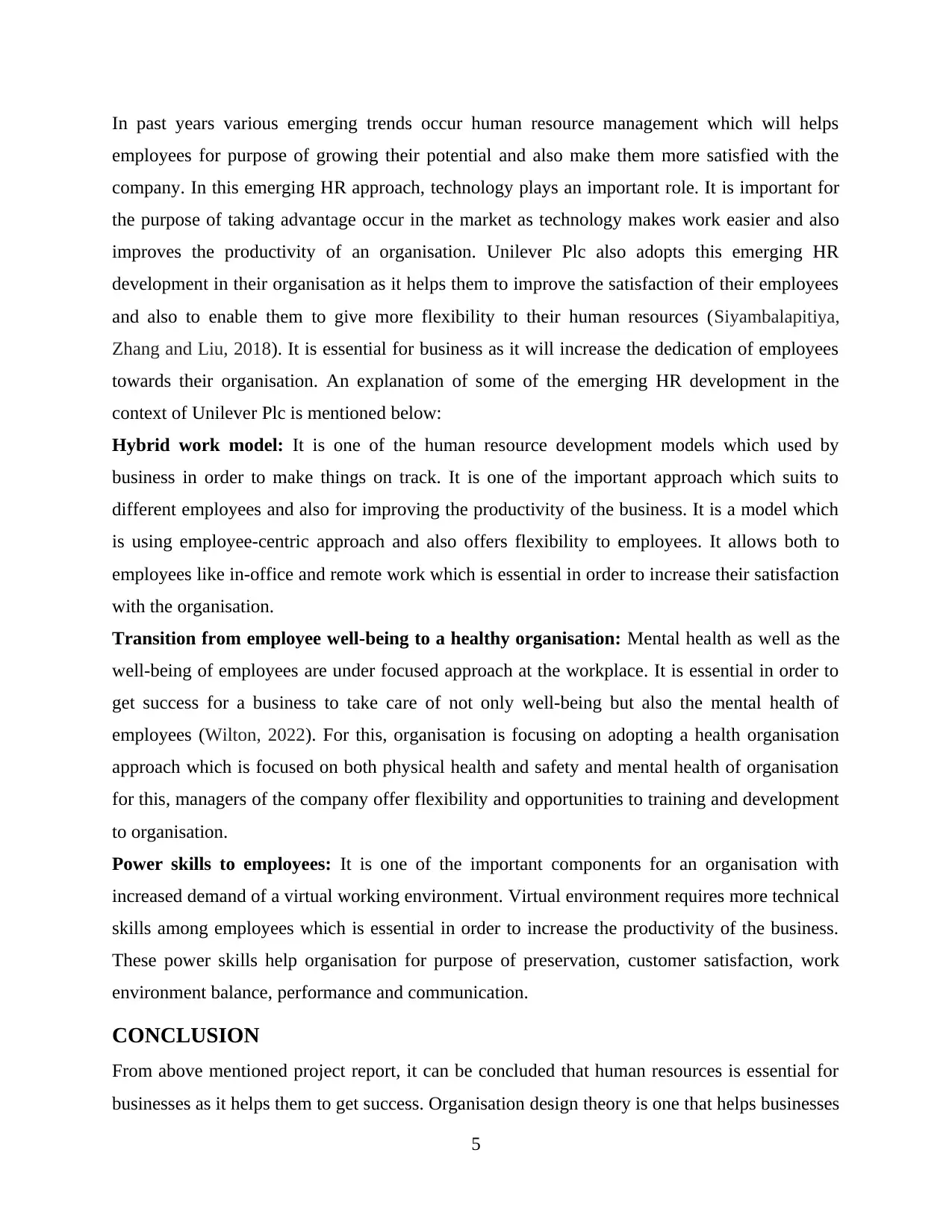
In past years various emerging trends occur human resource management which will helps
employees for purpose of growing their potential and also make them more satisfied with the
company. In this emerging HR approach, technology plays an important role. It is important for
the purpose of taking advantage occur in the market as technology makes work easier and also
improves the productivity of an organisation. Unilever Plc also adopts this emerging HR
development in their organisation as it helps them to improve the satisfaction of their employees
and also to enable them to give more flexibility to their human resources (Siyambalapitiya,
Zhang and Liu, 2018). It is essential for business as it will increase the dedication of employees
towards their organisation. An explanation of some of the emerging HR development in the
context of Unilever Plc is mentioned below:
Hybrid work model: It is one of the human resource development models which used by
business in order to make things on track. It is one of the important approach which suits to
different employees and also for improving the productivity of the business. It is a model which
is using employee-centric approach and also offers flexibility to employees. It allows both to
employees like in-office and remote work which is essential in order to increase their satisfaction
with the organisation.
Transition from employee well-being to a healthy organisation: Mental health as well as the
well-being of employees are under focused approach at the workplace. It is essential in order to
get success for a business to take care of not only well-being but also the mental health of
employees (Wilton, 2022). For this, organisation is focusing on adopting a health organisation
approach which is focused on both physical health and safety and mental health of organisation
for this, managers of the company offer flexibility and opportunities to training and development
to organisation.
Power skills to employees: It is one of the important components for an organisation with
increased demand of a virtual working environment. Virtual environment requires more technical
skills among employees which is essential in order to increase the productivity of the business.
These power skills help organisation for purpose of preservation, customer satisfaction, work
environment balance, performance and communication.
CONCLUSION
From above mentioned project report, it can be concluded that human resources is essential for
businesses as it helps them to get success. Organisation design theory is one that helps businesses
5
employees for purpose of growing their potential and also make them more satisfied with the
company. In this emerging HR approach, technology plays an important role. It is important for
the purpose of taking advantage occur in the market as technology makes work easier and also
improves the productivity of an organisation. Unilever Plc also adopts this emerging HR
development in their organisation as it helps them to improve the satisfaction of their employees
and also to enable them to give more flexibility to their human resources (Siyambalapitiya,
Zhang and Liu, 2018). It is essential for business as it will increase the dedication of employees
towards their organisation. An explanation of some of the emerging HR development in the
context of Unilever Plc is mentioned below:
Hybrid work model: It is one of the human resource development models which used by
business in order to make things on track. It is one of the important approach which suits to
different employees and also for improving the productivity of the business. It is a model which
is using employee-centric approach and also offers flexibility to employees. It allows both to
employees like in-office and remote work which is essential in order to increase their satisfaction
with the organisation.
Transition from employee well-being to a healthy organisation: Mental health as well as the
well-being of employees are under focused approach at the workplace. It is essential in order to
get success for a business to take care of not only well-being but also the mental health of
employees (Wilton, 2022). For this, organisation is focusing on adopting a health organisation
approach which is focused on both physical health and safety and mental health of organisation
for this, managers of the company offer flexibility and opportunities to training and development
to organisation.
Power skills to employees: It is one of the important components for an organisation with
increased demand of a virtual working environment. Virtual environment requires more technical
skills among employees which is essential in order to increase the productivity of the business.
These power skills help organisation for purpose of preservation, customer satisfaction, work
environment balance, performance and communication.
CONCLUSION
From above mentioned project report, it can be concluded that human resources is essential for
businesses as it helps them to get success. Organisation design theory is one that helps businesses
5
Paraphrase This Document
Need a fresh take? Get an instant paraphrase of this document with our AI Paraphraser
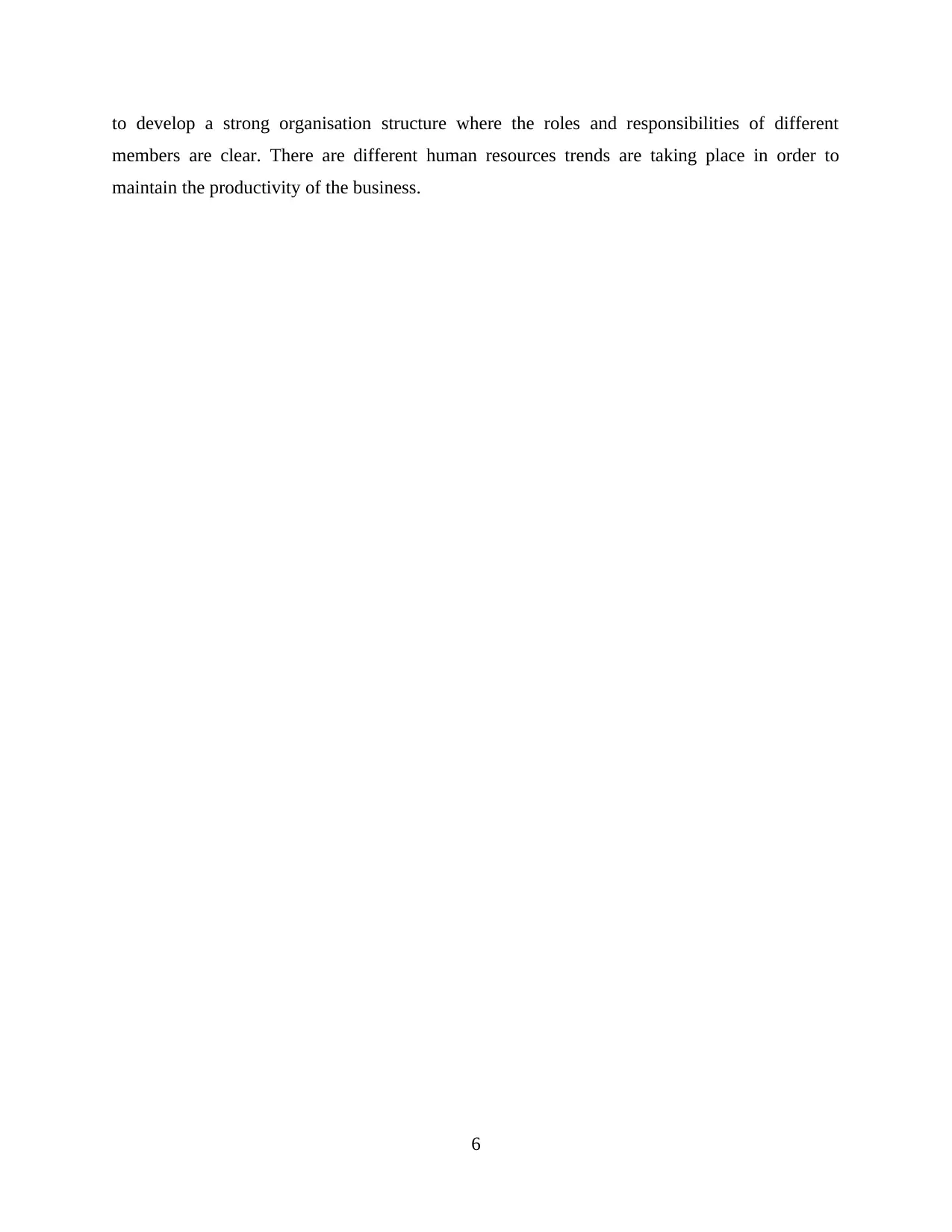
to develop a strong organisation structure where the roles and responsibilities of different
members are clear. There are different human resources trends are taking place in order to
maintain the productivity of the business.
6
members are clear. There are different human resources trends are taking place in order to
maintain the productivity of the business.
6
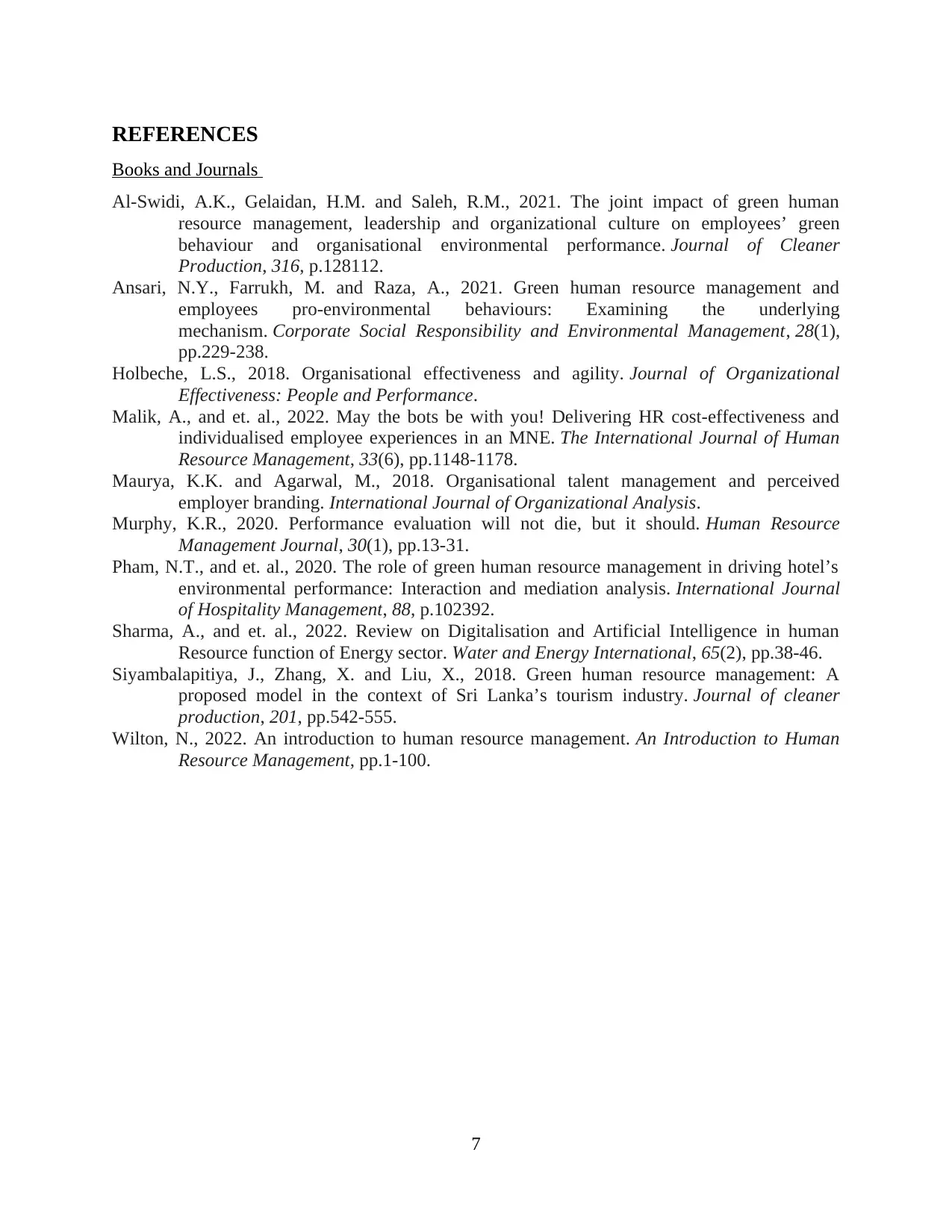
REFERENCES
Books and Journals
Al-Swidi, A.K., Gelaidan, H.M. and Saleh, R.M., 2021. The joint impact of green human
resource management, leadership and organizational culture on employees’ green
behaviour and organisational environmental performance. Journal of Cleaner
Production, 316, p.128112.
Ansari, N.Y., Farrukh, M. and Raza, A., 2021. Green human resource management and
employees pro‐environmental behaviours: Examining the underlying
mechanism. Corporate Social Responsibility and Environmental Management, 28(1),
pp.229-238.
Holbeche, L.S., 2018. Organisational effectiveness and agility. Journal of Organizational
Effectiveness: People and Performance.
Malik, A., and et. al., 2022. May the bots be with you! Delivering HR cost-effectiveness and
individualised employee experiences in an MNE. The International Journal of Human
Resource Management, 33(6), pp.1148-1178.
Maurya, K.K. and Agarwal, M., 2018. Organisational talent management and perceived
employer branding. International Journal of Organizational Analysis.
Murphy, K.R., 2020. Performance evaluation will not die, but it should. Human Resource
Management Journal, 30(1), pp.13-31.
Pham, N.T., and et. al., 2020. The role of green human resource management in driving hotel’s
environmental performance: Interaction and mediation analysis. International Journal
of Hospitality Management, 88, p.102392.
Sharma, A., and et. al., 2022. Review on Digitalisation and Artificial Intelligence in human
Resource function of Energy sector. Water and Energy International, 65(2), pp.38-46.
Siyambalapitiya, J., Zhang, X. and Liu, X., 2018. Green human resource management: A
proposed model in the context of Sri Lanka’s tourism industry. Journal of cleaner
production, 201, pp.542-555.
Wilton, N., 2022. An introduction to human resource management. An Introduction to Human
Resource Management, pp.1-100.
7
Books and Journals
Al-Swidi, A.K., Gelaidan, H.M. and Saleh, R.M., 2021. The joint impact of green human
resource management, leadership and organizational culture on employees’ green
behaviour and organisational environmental performance. Journal of Cleaner
Production, 316, p.128112.
Ansari, N.Y., Farrukh, M. and Raza, A., 2021. Green human resource management and
employees pro‐environmental behaviours: Examining the underlying
mechanism. Corporate Social Responsibility and Environmental Management, 28(1),
pp.229-238.
Holbeche, L.S., 2018. Organisational effectiveness and agility. Journal of Organizational
Effectiveness: People and Performance.
Malik, A., and et. al., 2022. May the bots be with you! Delivering HR cost-effectiveness and
individualised employee experiences in an MNE. The International Journal of Human
Resource Management, 33(6), pp.1148-1178.
Maurya, K.K. and Agarwal, M., 2018. Organisational talent management and perceived
employer branding. International Journal of Organizational Analysis.
Murphy, K.R., 2020. Performance evaluation will not die, but it should. Human Resource
Management Journal, 30(1), pp.13-31.
Pham, N.T., and et. al., 2020. The role of green human resource management in driving hotel’s
environmental performance: Interaction and mediation analysis. International Journal
of Hospitality Management, 88, p.102392.
Sharma, A., and et. al., 2022. Review on Digitalisation and Artificial Intelligence in human
Resource function of Energy sector. Water and Energy International, 65(2), pp.38-46.
Siyambalapitiya, J., Zhang, X. and Liu, X., 2018. Green human resource management: A
proposed model in the context of Sri Lanka’s tourism industry. Journal of cleaner
production, 201, pp.542-555.
Wilton, N., 2022. An introduction to human resource management. An Introduction to Human
Resource Management, pp.1-100.
7
⊘ This is a preview!⊘
Do you want full access?
Subscribe today to unlock all pages.

Trusted by 1+ million students worldwide
1 out of 9
Related Documents
Your All-in-One AI-Powered Toolkit for Academic Success.
+13062052269
info@desklib.com
Available 24*7 on WhatsApp / Email
![[object Object]](/_next/static/media/star-bottom.7253800d.svg)
Unlock your academic potential
Copyright © 2020–2025 A2Z Services. All Rights Reserved. Developed and managed by ZUCOL.



